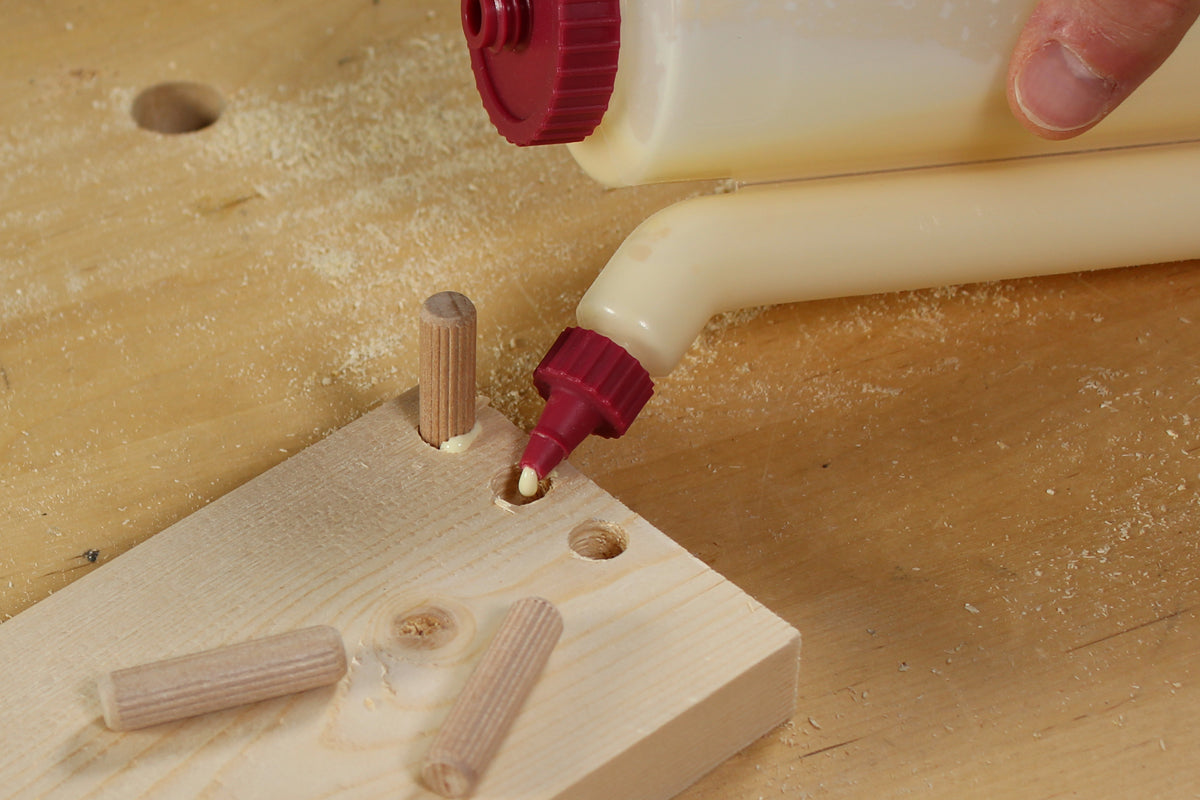Jonathan Salisbury looks at the GlueMate 150 and 450, available from Wood Workers Workshop, which promise to offer a better way of storing and dispensing adhesives.
The Woodworker & Good Woodworking
Buying small bottles of wood glue makes sense if you don’t use much, but I’ve never found that they work very well. The tip of the spout usually needs cutting to obtain the right size hole, but then the cap never seems to fit very well. Glue often dries up in the small nozzles, making squeezing more difficult and regular unblocking a necessity; for the quantity purchased, they’re also relatively expensive.
Buying in bulk is cheaper, but it’s not feasible to pour small amounts of glue directly from a five-litre container. Decanting PVA into a small pot and using a spreader is possible, but that’s not always convenient and there’s usually some left over to either clean up or allow to dry, which is also wasteful. A bottle is still best in most cases.
The GlueMate 150, and its larger sibling the 450, are Milescraft’s version of a solution to the need for a refillable, squeezable glue bottle, which can be used to dispense the correct amount – no more, no less – exactly where it’s required.
How they work
What makes them different from the traditional bottle is that they’re divided into two sections: the reservoir and a dispensing tube. Adhesive can be bought in bulk and easily decanted into each bottle via the wide necks. When squeezed, the glue is forced down to the reservoir’s base, up the tube and through the nozzle; the bottles are transparent, which allows you to see how much glue is on its way and when it’s going to reach the end. There are two types of applicator tip – a ‘biscuit’ for a wider bead and a ‘point cone’ for precision spots and finer beads. Each comes with a securely-fitting cap to prevent glue from drying out. The filler cap has a screw thread on top that arrives covered with a black rubber cap; this thread can be used to store the unused applicator tip, ready for use.
Why they’re better
Glue is only dispensed when the bottle is squeezed and, since any that doesn’t make
it out of the tip gets sucked back into the tube when the pressure is released, there are no drips; apart from a small amount that dries around the cap, there’s no wastage. The bottles are very flexible and therefore easy to squeeze, and they work when upright or on their side, pointing downwards or upwards. You don’t need to turn them upside down and, in any case, they wouldn’t work if you did.
Another advantage is that the glue being dispensed is as far away from the filling point as it can be. In most bottles, the neck is below the nozzle and, since this point is where the glue is likely to dry out first, there are often blockages to deal with. After several weeks of use, there’s no sign of lumps in either bottle; the caps and screw lids do a great job of sealing out the air. The only dried glue was a little around the cap on the outside of the applicator tip, and this was easy to clear as it didn’t form a good bond between the plastic surfaces.
Spares
The only replaceable parts on the Wood Workers Workshop website are the applicator tips, although Milescraft also list the tip caps and screw-top filler cap. I’m sure that, if taken care of, they’ll never need replacing.
Conclusion
When it comes to squeezing PVA onto wood, there are few alternatives to the original bottles. The convenience of not having to use those little opaque bottles that PVA is often supplied in has to be one of the deciding factors when value is being determined. In addition, by making over-application easier to avoid, less glue is wasted. The 150 is ideal for small jobs or getting into tight spaces, while the 450 lasts longer before refilling, making it more suitable for gluing up larger projects. At £6.95 and £8.45 respectively, they’re no bargain (being made in the USA, the price is higher than in their homeland due to the costs of transport) although certainly superior to the 1 litre bottle the glue was supplied in. For a busy woodworker with a lot of gluing to do, however, the ease of use and reduced waste is worth paying for.
Specification
- Holds up to 150ml or 450ml
- Works with most glues
- Double chamber system for gluing at any angle
- Narrow application tube helps to control flow and apply precise amounts
- Won’t drip or spill
- Wide mouth for easy filling
- Fine cone applicator for fine beads
- Flat biscuit applicator for wide flat beads
- Replaceable tips available
The Verdict
- Pros: Easy to dispense the right amount of glue in the right place; interchangeable tips can be used for a range of applications; less wasteful – unused glue is drawn back into the bottle; sealed bottle prevents glue from drying out; saves money – glue can be bought in bulk
- Cons: None
- Performance Rating: 5 out of 5
- Value Rating: 4 out of 5

